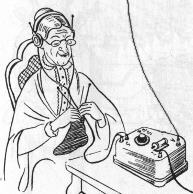
 Gollumīs Crystal
Receiver World
Gollumīs Crystal
Receiver World
 Gollumīs Crystal
Receiver World
Gollumīs Crystal
Receiver WorldIn the starting time of the broadcast "detectors" (crystal sets) were used to the reception of broadcast stations. The broadcast started in Germany in the year 1923 (USA 1919- 1920, Australia 1921?, France 1921, England 1922, New Zealand 1923, Switzerland 1923, Austria 1924).
The detector usually made headphone reception possible. The detector obtains his complete energy from the transmitter signal. An additional voltage supply wasn't required. Exception: detectors with rectifier material, that an additional bias voltage required.
 The
detector receiver (crystal receiver) has the following
components: Coil and variable capacitor (resonance circuit), rectifier, headphone,
aerial (antenna), earth (ground).
The
detector receiver (crystal receiver) has the following
components: Coil and variable capacitor (resonance circuit), rectifier, headphone,
aerial (antenna), earth (ground).
Inventor of crystal receiver: Karl Ferdinand Braun, crystal rectifier1874, point contact for crystal rectifier1898, crystal receiver1906.
The selected RF signal was changed in NF and supplied the rectifier with the headphone. The rectifiers had to be used circumstantially at the first detectors. A small wire tip had to be put exactly on the semiconductor. Later, ready Germanium semiconductors (e.g. 1N34) were used. Good detectors absolutely could separate several transmitters from each other and offered even long-distance reception. Special attraction of the detector is the "current-free" reception.
 The crystal sets were
replaced by tubes
receivers soon. These receivers were more powerful and more
selective. In addition, these radios offer loudspeaker reception.
Also today you can order construction kits
and components for building crystal
sets.
The crystal sets were
replaced by tubes
receivers soon. These receivers were more powerful and more
selective. In addition, these radios offer loudspeaker reception.
Also today you can order construction kits
and components for building crystal
sets.
The good time of the MW (BC) broadcast is in Germany past. Many transmitters only use transmit powers of under 5 KW. Transmitters are already tested in digital modulation. Unfortunately, the end of the detectors approach. We still enjoy the remaining years. My home brew crystal set receives up to 55 transmitters from 22 European countries at night.
More information about early crystal rectifiers and germanium diodes you will find at my "Wumpusīs Old Radio World" pages.